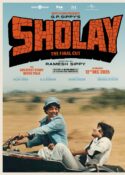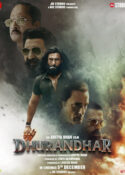 With supernatural horrors Click, Hide & Seek and Shaapit about to hit cinemas ready to chill and thrill audiences, it’s a good time to take a look back at this interesting, but little explored genre of Hindi cinema.
With supernatural horrors Click, Hide & Seek and Shaapit about to hit cinemas ready to chill and thrill audiences, it’s a good time to take a look back at this interesting, but little explored genre of Hindi cinema.
Widely acknowledged as the first Indian horror film was Kamaal Amrohi’s Mahal (1949), the film was a haunting ghost story which starred Ashok Kumar as the new resident of a strange mansion that had a tragic history. Shot in the then fashionable eerily atmospheric German Expressionistic style by German cinematographer Joseph Wirsching, the film also stars the ethereal Madhubala and features Lata Mangeshkar’s first hit song: ‘Ayega Aanewala’. Notable as one of the earliest movies in the world to deal with the theme of reincarnation and rebirth, Mahal has remained influential right up into the present day, inspiring numerous films on the same theme, including Madhumati (1958), Karz (1980), Karan Arjun (1995), Om Shanti Om (2007), and Love Story 2050 (2008).
Bimal Roy worked as the editor on Mahal, and was so inspired he went on to direct his own film: Madhumati. Another touchstone film in the pantheon of Hindi horror, Madhumati, starring Dilip Kumar, was the first Hindi film to feature avenging spirits – a trope now commonplace in Indian horror films, but novel enough at the time to help make Madhumati into a box office smash.
From Mahal and Madhumati on, the supernatural would go on to become a popular theme in Hindi horror. Many early horrors focused on the plight of bhatki hui aatmas (lost souls); and the bhoot (ghost; literally ‘has-been’, as in: someone or something that has been alive, but now is not), with spirits continuing to even pop up today in films that are not strictly of the horror genre (think Shah Rukh’s trickster character in Paheli, or Amitabh Bachchan’s kindly ghost in Bhoothnath).
Besides the ‘classic ghost story’, directors also explored other ways to scare you including their take on the quintessential “monster movie”. Many sources cite Nagin (1976) and Jaani Dushman (1979) as classic examples of Hindi horror stories taking inspiration from early monster movies. In Nagin (The Female Snake), a shape-shifting snake menaces an all-star cast of Sunil Dutt, Jeetendra, Rekha, Reena Roy, Feroz Khan, Kabir Bedi and Mumtaz, seeking vengeance after they kill her mate. Jaani Dushman sees Sanjeev Kumar as a werewolf, bloodthirstily preying on young brides. Both films were (pardon the pun) “monster” hits.
 In the late 1970s and 1980s, the classic ghost stories about reincarnated souls took a back seat as Hindi horror film-makers shifted their focus to films that derived their scares from serial killers and plenty of gore (a move that reflected what Hollywood horror films were tending towards with the rising popularity of slasher flicks like Halloween and zombie films like Dawn of the Dead). This period was dominated in India by the Ramsay Brothers – filmmakers who even today are regarded as the “Kings” of the horror movie genre, having made hundreds of low budget, “B-grade” horror flicks, almost all of them containing the same formulaic plot elements, most importantly: a scantily clad heroine, a monster (or occasionally an evil spirit), and extremely low-budget special effects.
In the late 1970s and 1980s, the classic ghost stories about reincarnated souls took a back seat as Hindi horror film-makers shifted their focus to films that derived their scares from serial killers and plenty of gore (a move that reflected what Hollywood horror films were tending towards with the rising popularity of slasher flicks like Halloween and zombie films like Dawn of the Dead). This period was dominated in India by the Ramsay Brothers – filmmakers who even today are regarded as the “Kings” of the horror movie genre, having made hundreds of low budget, “B-grade” horror flicks, almost all of them containing the same formulaic plot elements, most importantly: a scantily clad heroine, a monster (or occasionally an evil spirit), and extremely low-budget special effects.
Frequently cited, as the best Ramsay Brothers production is Do Gaz Zameen Ke Neeche. The film features Shobha vamping it up as a murderess that is tormented when one of her victims returns from beyond the grave to punish her.
The Ramsay Brothers films were EXTREMELY popular, because what they lacked in technical expertise they made up for in entertainment value and sheer infectious love of moviemaking. The Ramsay Brothers built themselves a dedicated following and carved out a definite niche market. Unfortunately, they were so successful with their decidedly low-budget, schlocky horrors that for a long time, “Hindi horror” became largely equated in many people’s minds with “B-grade schlock”, rather than “mainstream appeal”. Other films to check out from this period include the Psycho-esque Red Rose (1980) – featuring superstar Rajesh Khanna in a negative role as a serial killer who lures young women to his house to kill them (the film so ill-received by audiences it triggered protests in Mumbai and Delhi); Jaadu Tona (1980) – an Exorcist-like tale of possession starring Feroz Khan and Reena Roy; and the Ramsay Brothers’ films Purana Mandir (1984), and Saamri (1985), which featured Saamri, one of the most famous monsters of the Ramsay Brothers’ stable.
As audiences’ tastes have grown more sophisticated in recent decades, attempts have been made to bring horror films out of the B-grade and into the mainstream, in many instances taking inspiration from successful Hollywood films, and investing effort and resources into creating effective special effects that can compete against successful Hollywood blockbusters. In recent years, director Ram Gopal Varma has been instrumental in the resurgence of interest in the Hindi horror genre.
His first attempt to resurrect and reinvent the genre was with Raat (1992), and later Bhoot (2003), a modern-day classic, regarded as one of the scariest contemporary films. Bhoot sees Ajay Devgan and Urmila Matondkar dealing with a ghost trapped in a Mumbai apartment. The film’s high production values and distinctive and effective sound design mark it out as setting a new benchmark for Hindi horror. Varma has gone on to make several horror films, including most recently Darling, Vastu Shashtra, and Phoonk, with Phoonk 2 on its way.
 Filmmakers Mahesh Bhatt and Priyadarshan have both also dabbled in horror films. Among the surge of recent popular horrors are Raaz and Raaz 2: The Mystery Continues; Saaya, Gauri, Kucch To Hai, 1920, Hum Kaun Hain, Bhool Bhulaiya, 8×10 Tasveer, Krishna Cottage, 13B; as well as a raft of well-known horror films stemming from the South Indian film industry, including Bhargavi Nilayam, Manichitrathazhu, Chandramukhi, and Eraa.
Filmmakers Mahesh Bhatt and Priyadarshan have both also dabbled in horror films. Among the surge of recent popular horrors are Raaz and Raaz 2: The Mystery Continues; Saaya, Gauri, Kucch To Hai, 1920, Hum Kaun Hain, Bhool Bhulaiya, 8×10 Tasveer, Krishna Cottage, 13B; as well as a raft of well-known horror films stemming from the South Indian film industry, including Bhargavi Nilayam, Manichitrathazhu, Chandramukhi, and Eraa.
Releasing tomorrow is Sangeeth Sivan’s first foray into the genre with Click starring Shreyas Talpade, Sada, Sneha Ullal, Rehan Khan and Chunky Pandey. It is back to the supernatural for this one and according to the director in an interview with Bollyspice, “Click tries to explore the phenomena of spirits as they appear in photographs. It’s also a love story and an investigative film too, surprising one at every turn. The spine of the story is horror -the love stories and the investigations are the sub plots.”
Hide&Seek is getting set to terrify you on March 12th. The film is more of the thriller/horror genre where 6 adults are trapped in a mall and forced to play Hide and Seek for their lives and noone knows who the killer is. Directed by newcomer Shawn Arranha and produced by Apoorva Lakhia, it stars a host of up-and-coming including Amruta Patki, Mrinalini Sharma, Ayaz Khan, Samir Kocchar, Arjan Bawja and Purab Kohli.
March 19th will see the return of Vikram Bhatt to the horror genre with Shaapit. This one has a curse, a love story and according to music director Chirantan Bhatt, “It is a horror flick, but it is a very Bollywood style horror flick with all the romance and the songs and everything.” Aditya Narayan (son of veteran singer Udit Narayan) debuts in the film, which also stars Shweta Agarwal in the main lead of Kaaya.
Whatever it is that sends chills up your spine, be it a good old fashioned ghost story or a more contemporary take on things that go bump in the night, you can be sure that a Bollywood film exists that will give you goose bumps. One thing is for certain – these films ARE scary! Watch at your own risk!









